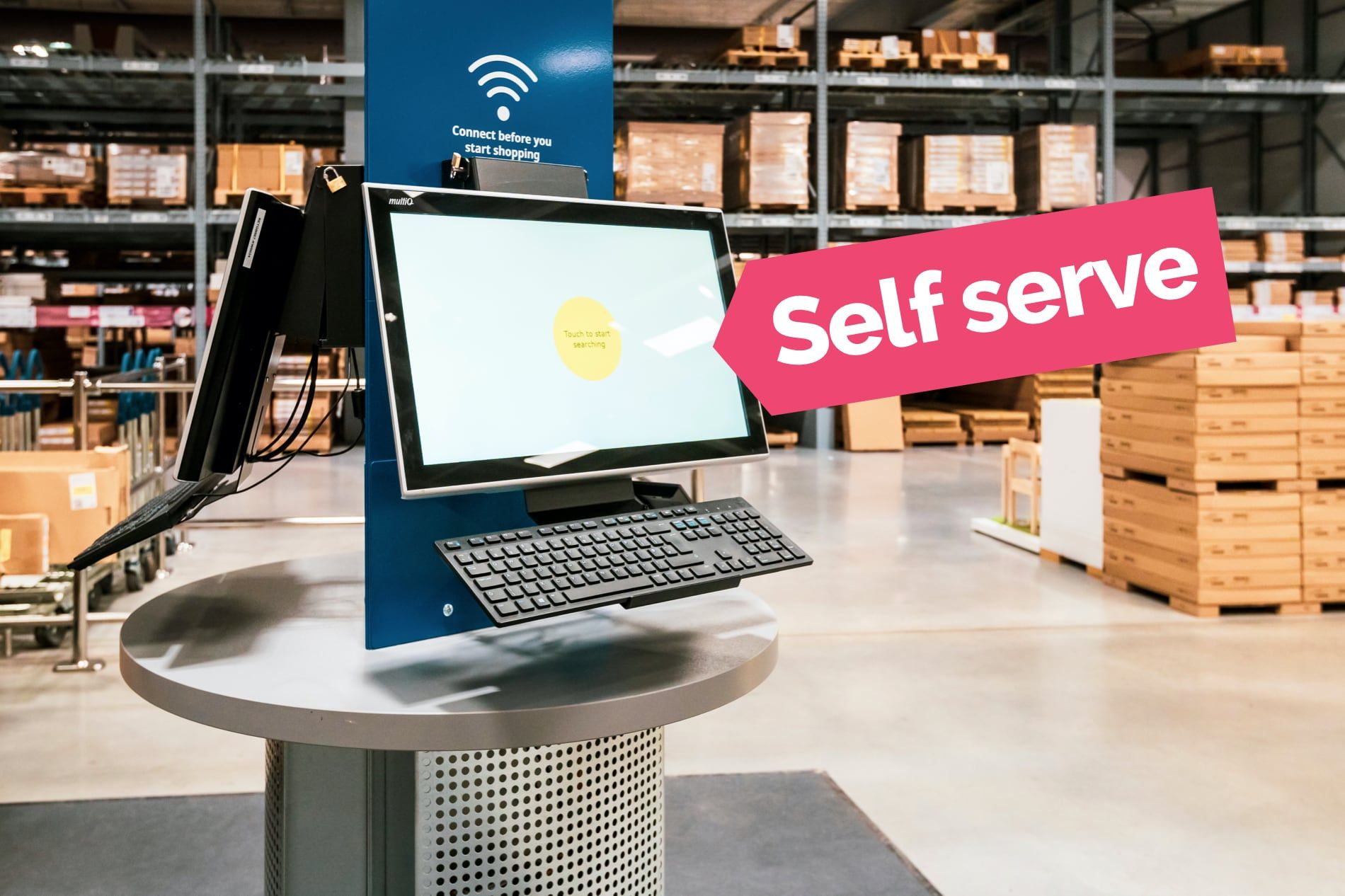The world is always changing but most would agree that things have never been moving quite as fast as they are today. Customers are now leading busier and busier hyper-connected lives and the internet is now where most commerce takes place.
In response to this customer service is also undergoing a significant transformation. As businesses strive to meet the ever-increasing demands and “real time” expectations of their customers, self service and automation have emerged as powerful solutions.
In this blog post, we will explore the future of customer service and how self service and automation are key to shaping the way businesses interact with their customers. We will also cover the important points for you to consider when deciding how to best implement a self service system.
The Rise of self service
In an era where instant gratification and efficiency are paramount, self service has become a popular choice for customers and the businesses that service them.

Self service empowers consumers to find answers and resolve issues on their own, without the need for human intervention. From online FAQs and knowledge bases to highly bespoke web and mobile applications (such as those offered by banks, retailers, travel agencies, transportation providers etc etc) self service options provide customers with quick and convenient solutions.
Benefits of self service
- 24/7 availability: self service platforms can be accessed at any time, allowing customers to find assistance whenever they need it.
- Reduced wait times: By bypassing the need to speak with a customer service representative, customers can resolve their queries instantly, avoiding long hold times.
- Empowerment and control: self service options put the power in the hands of customers, enabling them to find information and resolve issues independently.
- Consistency and accuracy: Automated self service systems can provide consistent and accurate information, ensuring customers receive reliable support.
- Implementing self service options can lead to substantial cost savings for businesses. Forrester Research estimated that the average cost of a customer service interaction through self service channels is around $0.10, compared to $6-$12 for a live agent-assisted interaction.
Customers like it
Online customer self service systems have gained significant popularity in recent years. According to a survey by Nuance Communications, 67% of customers prefer self service over speaking to a company representative.
Self service systems, when well-designed and implemented, can enhance customer satisfaction. According to a survey conducted by Zendesk, two thirds of customers prefer self service over speaking to a support agent - if it is easy to use.
The Role of Automation
Automation plays a crucial role in the future of customer service. It can involve the use of artificial intelligence (AI) and machine learning (ML) technologies to streamline processes and enhance customer interactions. From chatbots and virtual assistants to automated email responses, the real-time processing of customer requests, personalised recommendations and so on automation is revolutionising the way businesses engage with their customers.

Advantages of Automation
- Faster response times: automated systems can provide instant responses to customer queries, reducing response times and improving overall satisfaction.
- Personalisation: automation can analyse customer data and preferences to deliver tailored options, recommendations and/or personalised experiences.
- Cost efficiency: By automating routine tasks, businesses can reduce the need for human resources, leading to cost savings.
- Scalability: automated systems can handle a large volume of customer inquiries simultaneously, ensuring scalability and efficiency during peak periods.
- Consistency: automated systems can be consistent in the application of business rules or logic, humans dealing with customers are sometimes not always as reliable or may not be fully trained.
Achieving the Right Balance

While self service and automation offer numerous benefits, it is essential to strike the right balance between automated systems and human interaction. Some customers may still prefer speaking with a live representative, especially in complex or emotionally charged situations. Therefore, businesses should aim to offer a hybrid approach, combining self service options with accessible channels for human assistance.
Key Considerations
- Clear communication: It is crucial to communicate the availability and limitations of self service options to customers, setting appropriate expectations.
- Seamless transition: Implementing automated systems should be seamless, with easy escalation to human support when necessary.
- Continuous improvement: Regularly collect customer feedback and data to refine and improve self service and automation offerings, ensuring they meet evolving needs.
Many businesses see a key benefit of online self service systems being the time it frees up for humans to deal with the more complicated or nuanced cases. Dealing with these “edge cases” or “exceptions” can also be more rewarding for the staff involved too.
How to implement customer self service tools

Here are some steps to consider when implementing a customer self service system:
- Define your goals: Determine the objectives you want to achieve with the self service system. Examples could include reducing support costs, improving customer satisfaction, or increasing efficiency.
- Identify customer needs: Understand the most common customer inquiries and pain points. Analyse any existing customer support data and perhaps conduct surveys and/or gather feedback to identify the areas where self service can be most effective.
- Choose the right platform: Select a self service platform that aligns with your business requirements. Consider factors such as ease of use, customisation options, integration capabilities with your existing systems, and scalability. Malcolm! is very good 🙂
- Develop a knowledge base: Create a comprehensive knowledge base that covers common customer queries, FAQs, troubleshooting guides, and any other relevant information. Organise the content in a user-friendly and searchable manner, using categories and tags.
- Provide multiple access points: Make sure the self service system is easily accessible to customers. Provide links on your website, mobile apps, and customer portals. Consider surfacing some content contextually, for example Malcolm! offers embeds to do just this!
- Ensure intuitive navigation: Design a user-friendly interface that is easy to navigate and reflects your brand accurately. Use clear headings, logical categories, and a search function to help customers quickly find the information they need.
- Regularly update and improve content: Review and update your knowledge base regularly to ensure accuracy and relevance. Track customer inquiries to identify gaps in the content and add new articles or resources accordingly. Encourage user feedback to continuously improve the system.
- Integrate with other systems: Integrate your self service system with other customer support channels and systems, such as ticketing systems or live chat tools. This enables seamless transitions for customers who require further assistance beyond self service.
- Promote self service options: Educate your customers about the availability and benefits of the self service system. Use various channels, such as email newsletters, email signatures, website banners, messages on your telephone system, social media, and automated responses, to highlight the self service options and encourage adoption. You can also encourage your staff to mention the online tools whenever they speak to customers.
- Monitor and analyse usage: Track and analyse metrics related to your self service system, such as search queries, page views, and customer feedback. Identify trends, areas for improvement, and potential gaps in your knowledge base to optimise the system further.
- Provide human support when needed: While the self service system aims to resolve customer issues independently, some situations may require human assistance. Ensure there is a clear escalation path for customers to contact support agents when necessary.
- Continuously optimise and iterate: Regularly evaluate the effectiveness of your self service system and make improvements based on customer feedback and usage data. Keep up with evolving customer needs and technology advancements to stay ahead.
- Consider a phased rollout of your self service system, for example you could initially introduce it to a subset of your customer base to get feedback and learnings before rolling it out to all customers.
Remember, implementing a customer self service system is an iterative process. It requires ongoing monitoring, maintenance, and improvements to provide an optimal self service experience for your customers.
It’s important that your brand values, tone of voice and way of doing things is not lost when you implement customer self service tools. Your customers should still feel they are dealing with the same brand they were before. Care should be taken to ensure that the same ethos comes through in the communications the system generates and that the business decisions and rules applied by the automated systems match those your customers would expect from your most senior human staff.

It’s very important to give your customers the opportunity to easily feedback on the system and the content within it. Malcolm! offers in-built feedback functionality which makes it very easy to collect your customer’s opinions and thoughts.
Conclusion
The future of customer service lies in the successful integration of self service and automation alongside access to quality human resources when they are needed.
Businesses that embrace these technologies can enhance customer satisfaction, improve operational efficiency, and stay ahead in today's competitive landscape.
There is a particular opportunity for smaller businesses, as they are able to leverage self service systems and automation to scale their customer service operation, gaining a competitive advantage over their similarly sized competitors whilst competing with much bigger players. The investment required to implement self service systems like Malcolm! is a fraction of what it would cost to employ dedicated customer service staff, a cost that previously only large companies could finance.
By leveraging self service options and automation wisely, and approaching self service and automation as an ongoing initiative rather than a one off project companies can create a seamless and personalised customer experience, setting new standards for customer service excellence in the digital age.
Are you ready to start your customer self service journey? Why not sign up to our 14 day trial right now
